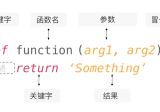一、字符串魔法
1、优雅的字符串翻转
message = "Python很神奇" reversed_message = message[::-1] # 输出:"奇神很nohtyP"
2、智能字符串组合
technologies = ["人工智能", "大数据", "云计算"] tech_stack = "、".join(technologies) # 输出:"人工智能、大数据、云计算"
3、现代字符串格式化
language = "Python"
version = 3.9
print(f"我正在使用{language} {version}版本") # f-string,Python 3.6+特性4、精确字符串分割
data = "红,橙,黄,绿,蓝,靛,紫"
colors = data.split(',') # 得到颜色列表5、字符串智能替换
quote = "生活就像一盒巧克力"
new_quote = quote.replace("巧克力", "算法") # 输出:"生活就像一盒算法"二、列表技巧
6、优雅地消除重复元素
numbers = [4, 7, 4, 2, 7, 8, 2, 9] unique_numbers = list(dict.fromkeys(numbers)) # 保持原顺序去重
7、一行式列表生成
cubes = [i**3 for i in range(1, 6)] # 输出:[1, 8, 27, 64, 125]
8、条件列表筛选
scores = [72, 86, 92, 63, 88, 76] passed = [score for score in scores if score >= 80] # 筛选高分
9、多维列表扁平化
matrix = [[1, 2], [3, 4], [5, 6]] flattened = sum(matrix, []) # 输出:[1, 2, 3, 4, 5, 6]
10、巧妙的列表切片
data = [1, 2, 3, 4, 5, 6, 7, 8, 9, 10] even_indexed = data[::2] # 取偶数索引:[1, 3, 5, 7, 9]
三、字典魅力
11、现代字典合并
user_info = {'name': '张三', 'age': 28}
more_info = {'city': '北京', 'email': 'zhang@example.com'}
profile = {**user_info, **more_info} # Python 3.5+特性12、动态创建键值对
letters = 'abcde'
letter_positions = {letter: index for index, letter in enumerate(letters, 1)} # 输出:{'a': 1, 'b': 2, 'c': 3, 'd': 4, 'e': 5}13、安全获取字典值
settings = {'theme': 'dark'}
font_size = settings.get('font_size', 12) # 键不存在返回默认值1214、一键提取多值
config = {'server': 'localhost', 'port': 8080, 'timeout': 30}
server, port = config.get('server'), config.get('port') # 更简洁: server, port = (config.get(k) for k in ('server', 'port'))15、字典排序新方式
menu = {'咖啡': 25, '茶': 15, '蛋糕': 30, '三明治': 20}
sorted_menu = dict(sorted(menu.items(), key=lambda x: x[1])) # 按价格排序四、文件处理艺术
16、上下文管理读取文件
with open('笔记.txt', 'r', encoding='utf-8') as document:
content = document.read() # 文件自动关闭,无需手动close()17、智能文件写入
data = ['第一行', '第二行', '第三行']
with open('output.txt', 'w', encoding='utf-8') as f:
f.write('\n'.join(data)) # 高效写入多行18、二进制文件处理
with open('image.jpg', 'rb') as img_file:
image_data = img_file.read()
file_size = len(image_data)
print(f"图片大小: {file_size} 字节")19、实时文件监控
def watch_file(filename): import time last_position = 0 while True: with open(filename, 'r') as f: f.seek(last_position) new_content = f.read() if new_content: print(new_content, end='') last_position = f.tell() time.sleep(1)
20、智能JSON处理
import json
data = {'users': [{'name': '李四', 'age': 30}, {'name': '王五', 'age': 25}]}
json_string = json.dumps(data, ensure_ascii=False, indent=2) # 美化输出中文五、函数与类的艺术
21、函数参数智能默认值
def connect_database(host='localhost', port=5432, user=None, timeout=5.0):
user = user or 'guest' # 智能默认值处理
print(f"连接到 {host}:{port} 用户:{user} 超时:{timeout}秒")22、函数参数解包技巧
def create_profile(name, age, *interests, **contact_info):
profile = {'name': name, 'age': age, 'interests': interests}
profile.update(contact_info)
return profile
# 使用:create_profile('小明', 22, '编程', '摄影', email='ming@example.com')23、纯函数式编程
calculate = lambda x, y, operation: {
'add': x + y,
'subtract': x - y,
'multiply': x * y,
'divide': x / y if y != 0 else '除数不能为零'
}.get(operation, '未知操作')
print(calculate(10, 5, 'multiply')) # 输出: 5024、高级装饰器模式
import time
def measure_time(func):
def wrapper(*args, **kwargs):
start = time.time()
result = func(*args, **kwargs)
end = time.time()
print(f"函数 {func.__name__} 执行时间: {end - start:.4f} 秒")
return result
return wrapper
@measure_time
def complex_calculation():
time.sleep(1) # 模拟复杂计算
return "计算完成"25、现代类设计
class SmartDevice:
def __init__(self, name, brand):
self.name = name
self.brand = brand
self._power = False
@property
def status(self):
return "开启" if self._power else "关闭"
def toggle_power(self):
self._power = not self._power
return f"{self.name}已{self.status}"
class SmartPhone(SmartDevice):
def __init__(self, name, brand, screen_size):
super().__init__(name, brand)
self.screen_size = screen_size六、数据处理与转换
26、函数式映射转换
temperatures_c = [0, 10, 20, 30, 40] # 摄氏度转华氏度 temperatures_f = list(map(lambda c: c * 9/5 + 32, temperatures_c))
27、声明式数据过滤
ratings = [4.5, 3.0, 4.8, 2.5, 4.2, 3.8, 1.9] # 筛选高评分 high_ratings = list(filter(lambda x: x >= 4.0, ratings))
28、数据配对与组合
products = ["手机", "电脑", "平板"]
prices = [3999, 5999, 2999]
inventory = list(zip(products, prices))
# 结果: [('手机', 3999), ('电脑', 5999), ('平板', 2999)]29、数据聚合与计数
from collections import Counter survey_results = ['A', 'B', 'A', 'C', 'B', 'A', 'A', 'D', 'C'] vote_counts = Counter(survey_results) most_common = vote_counts.most_common(2) # 获取前两名选项
30、数据分组聚合
from itertools import groupby
transactions = [
{'date': '2023-01-01', 'amount': 100},
{'date': '2023-01-01', 'amount': 200},
{'date': '2023-01-02', 'amount': 300},
]
# 按日期分组并计算总额
sorted_trans = sorted(transactions, key=lambda x: x['date'])
for date, group in groupby(sorted_trans, key=lambda x: x['date']):
total = sum(item['amount'] for item in group)
print(f"{date}: {total}")七、实用编程技巧
31、多变量交换
x, y, z = 1, 2, 3 y, z, x = x, y, z # 结果: x=3, y=1, z=2
32、简洁的条件链
age = 25 category = "儿童" if age < 12 else "青少年" if age < 18 else "成人"
33、序列解包赋值
data = ['张三', 30, '北京', 'Engineer'] name, age, *other_info = data # name='张三', age=30, other_info=['北京', 'Engineer']
34、区间范围检查
def check_blood_pressure(systolic, diastolic): return (90 <= systolic <= 120) and (60 <= diastolic <= 80)
35、安全类型转换
def safe_int(value, default=0):
try:
return int(value)
except (ValueError, TypeError):
return default
# 使用: user_id = safe_int(request.get('id'), -1)八、高级Python特性
36、生成器函数编写
def date_range(start, end):
"""生成指定范围内的日期"""
from datetime import datetime, timedelta
current = start
while current <= end:
yield current
current += timedelta(days=1)
# 遍历2023年1月的所有日期
from datetime import datetime
for date in date_range(datetime(2023, 1, 1), datetime(2023, 1, 31)):
print(date.strftime('%Y-%m-%d'))37、自定义环境管理器
class Timer:
def __enter__(self):
import time
self.start = time.time()
return self
def __exit__(self, *args):
import time
self.end = time.time()
print(f"运行时间: {self.end - self.start:.4f}秒")
# 使用方式
with Timer():
# 执行需要计时的代码
import time
time.sleep(1.5)38、高效数据枚举
seasons = ['春', '夏', '秋', '冬']
for i, season in enumerate(seasons, 1):
print(f"第{i}季度: {season}")39、递归计算与记忆化
from functools import lru_cache @lru_cache(maxsize=None) def factorial(n): """计算阶乘并缓存结果,避免重复计算""" return 1 if n <= 1 else n * factorial(n-1) print(factorial(10)) # 快速计算10的阶乘
40、智能集合操作
users_group1 = {'张三', '李四', '王五'}
users_group2 = {'李四', '王五', '赵六'}
# 集合运算
all_users = users_group1 | users_group2 # 并集
common_users = users_group1 & users_group2 # 交集
unique_to_group1 = users_group1 - users_group2 # 差集九、网络与API
41、异步HTTP请求
import asyncio
import aiohttp
async def fetch_data(url):
async with aiohttp.ClientSession() as session:
async with session.get(url) as response:
return await response.json()
async def main():
tasks = [
fetch_data('https://api.example.com/users'),
fetch_data('https://api.example.com/posts')
]
results = await asyncio.gather(*tasks)
return results42、REST API模拟
from flask import Flask, jsonify
app = Flask(__name__)
@app.route('/api/greeting/<name>')
def greeting(name):
return jsonify({
'message': f'你好,{name}!',
'timestamp': datetime.now().isoformat()
})43、文件下载器
def download_file(url, save_path): import requests response = requests.get(url, stream=True) if response.status_code == 200: with open(save_path, 'wb') as f: for chunk in response.iter_content(1024): f.write(chunk) return True return False
44、安全处理配置
import os
from dotenv import load_dotenv
# 从.env文件加载环境变量
load_dotenv()
DATABASE_URL = os.getenv('DATABASE_URL')
API_KEY = os.getenv('API_KEY')
DEBUG = os.getenv('DEBUG', 'False').lower() == 'true'45、命令行参数解析
import argparse
def setup_parser():
parser = argparse.ArgumentParser(description='数据处理应用')
parser.add_argument('--input', required=True, help='输入文件路径')
parser.add_argument('--output', default='output.csv', help='输出文件路径')
parser.add_argument('--verbose', action='store_true', help='显示详细日志')
return parser.parse_args()
args = setup_parser()
print(f"处理文件: {args.input} -> {args.output}")十、算法与数据结构
46、动态规划:斐波那契序列
def fibonacci_dynamic(n): """使用动态规划优化斐波那契计算""" if n <= 1: return n fib = [0] * (n + 1) fib[1] = 1 for i in range(2, n + 1): fib[i] = fib[i-1] + fib[i-2] return fib[n] # 计算斐波那契数列第20个数 print(fibonacci_dynamic(20)) # 比递归方法快得多
47、二分查找算法
def binary_search(arr, target): """二分查找实现""" left, right = 0, len(arr) - 1 while left <= right: mid = (left + right) // 2 if arr[mid] == target: return mid # 找到目标,返回索引 elif arr[mid] < target: left = mid + 1 # 在右半部分查找 else: right = mid - 1 # 在左半部分查找 return -1 # 未找到目标 sorted_nums = [1, 3, 5, 7, 9, 11, 13, 15] print(binary_search(sorted_nums, 7)) # 输出: 3
48、自定义排序
class Student:
def __init__(self, name, grade, age):
self.name = name
self.grade = grade
self.age = age
def __repr__(self):
return f"Student({self.name}, {self.grade}, {self.age})"
students = [
Student("小明", "A", 15),
Student("小红", "B", 14),
Student("小李", "A", 16)
]
# 先按成绩排序,成绩相同则按年龄升序
sorted_students = sorted(students, key=lambda s: (s.grade, s.age))49、图算法:广度优先搜索
from collections import deque
def bfs(graph, start):
"""广度优先搜索遍历图"""
visited = set()
queue = deque([start])
visited.add(start)
while queue:
vertex = queue.popleft()
print(vertex, end=" ")
for neighbor in graph[vertex]:
if neighbor not in visited:
visited.add(neighbor)
queue.append(neighbor)
# 示例图(邻接表表示)
graph = {
'A': ['B', 'C'],
'B': ['A', 'D', 'E'],
'C': ['A', 'F'],
'D': ['B'],
'E': ['B', 'F'],
'F': ['C', 'E']
}
print("BFS遍历结果:")
bfs(graph, 'A') # 输出: A B C D E F50、数据结构:实现简单缓存
class LRUCache: def __init__(self, capacity): from collections import OrderedDict self.cache = OrderedDict() self.capacity = capacity def get(self, key): if key not in self.cache: return -1 # 将访问的元素移动到末尾(最近使用) value = self.cache.pop(key) self.cache[key] = value return value def put(self, key, value): if key in self.cache: self.cache.pop(key) elif len(self.cache) >= self.capacity: # 删除最久未使用的元素(字典头部) self.cache.popitem(last=False) self.cache[key] = value # 使用示例 cache = LRUCache(2) cache.put(1, 1) cache.put(2, 2) print(cache.get(1)) # 返回 1 cache.put(3, 3) # 删除 key 2 print(cache.get(2)) # 返回 -1 (未找到)
Python是一门充满魔力的语言,它让复杂的编程任务变得简单优雅。通过掌握这50个编程技巧,你已经站在了Python编程的高级阶段。记住,编程不仅是一门技术,更是一门艺术——优雅的代码应该像诗歌一样,简洁而富有表现力。希望这些技巧能帮助你在Python的海洋中畅游,创造出更加高效、易读的代码作品!









